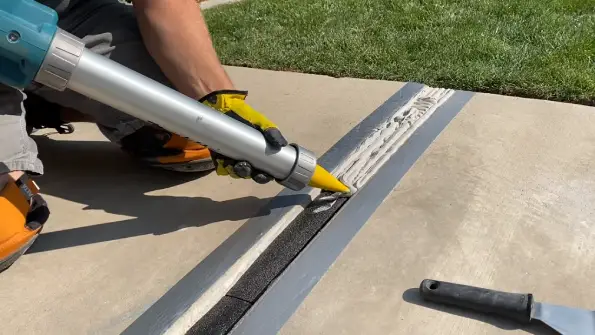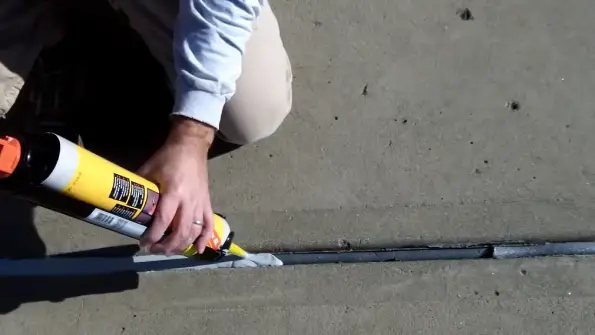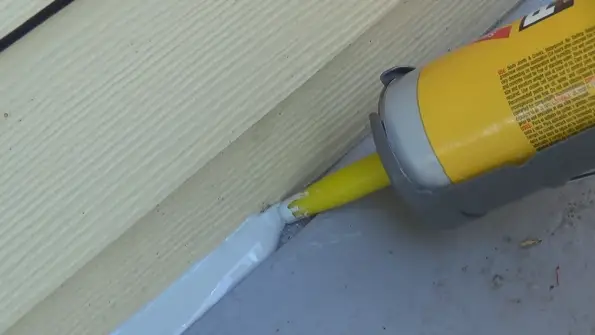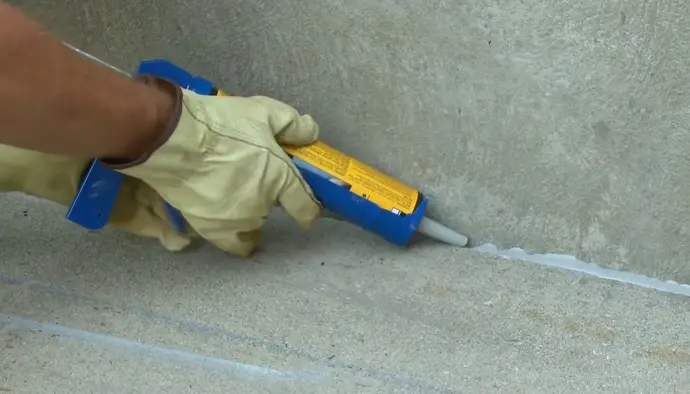Last Updated on June 22, 2023
It’s so important to choose the right sealant for concrete joints when building oxygen aeration basins.
These joints are critical for maintaining the integrity of the basin, preventing leaks, and ensuring that the aeration process runs smoothly.
With so many sealants on the market, however, it can be challenging to determine which one is best suited for your needs.
You will also be introduced to some of the top sealants on the market, along with their strengths and weaknesses, application process, and cost considerations.
By the end of this article, you will have a comprehensive understanding of what it takes to choose the best sealant for your oxygen aeration basin concrete joints, and how to ensure that it is installed properly for maximum effectiveness.
Importance of Choosing the Right Sealant for Oxygen Aeration Basin Concrete Joints
You need to choose the right sealant for oxygen aeration basin concrete joints, or you’ll risk leaks and damage to your system. The sealant types available in the market include polyurethane, silicone, and polysulfide.
The installation technique for each type varies, but it’s essential to ensure that the sealant is compatible with the concrete, has excellent adhesion, and is resistant to chemicals and UV rays.
Polyurethane sealants are widely used for their excellent adhesion, durability, and flexibility. They’re suitable for joints that experience movement and have a high resistance to chemicals and UV rays.
Silicone sealants are popular for their ability to withstand extreme temperatures, which makes them ideal for outdoor installations.
Polysulfide sealants are suitable for joints that require high elasticity, such as expansion joints. They also offer excellent resistance to chemicals and UV rays.
Proper installation techniques, including surface preparation, joint design, and application method, are crucial to ensure a long-lasting seal.
Factors to Consider When Choosing a Sealant

When choosing a sealant for your oxygen aeration basin concrete joints, there are several factors you need to consider.
You want a sealant that can move with the expansion and contraction of the concrete, adhere well to the surface, and last for a long time without deteriorating or cracking.
Flexibility
To ensure the best seal for your oxygen aeration basin concrete joint, it’s important to choose a sealant that offers flexibility, allowing it to move with the natural expansion and contraction of the concrete.
A flexible sealant will provide several benefits, including improved durability and impact resistance. As the concrete expands and contracts due to temperature changes and other factors, a rigid sealant can crack and break, compromising the seal and potentially leading to leaks and other issues.
When considering the flexibility of a sealant, it’s important to look at the product’s specifications and compare it to the expected movement of the concrete joint.
A sealant with a higher movement capability will be able to accommodate more expansion and contraction, providing a longer-lasting and more effective seal.
This can be evaluated by looking at the sealant’s elongation and joint movement capabilities, which should be listed in the product information.
| Benefit | Emotion | Impact |
| Improved durability | Confidence | Long-lasting protection |
| Impact resistance | Security | Protection from damage |
| Flexibility | Peace of mind | Accommodation of movement |
Adhesion
With adhesive properties being a crucial factor in protecting your oxygen aeration system, it’s important to consider the compatibility of the sealant with the materials it will be applied to. Adhesion testing is a must to ensure the sealant will bond well with the concrete joint.
Some factors to consider when testing adhesion include the type of concrete used, surface preparation techniques, and the environmental conditions where the sealant will be applied.
It’s important to clean, dry, and free of dust or debris before applying sealant to the concrete joint. Any contaminants left on the surface can negatively affect the adhesion of the sealant, leading to a weak bond and possible system failure.
Proper preparation may include using a wire brush or grinder to remove any loose particles, followed by a thorough cleaning with a solvent or degreaser.
Durability
Ensuring the longevity of the protective coating is essential for the maintenance of the oxygenation system. Long term effectiveness is one of the critical factors to consider when selecting the best sealant for the concrete joint in an oxygen aeration basin.
The sealant must be able to withstand harsh environmental conditions and exposure to wastewater. Moreover, it should have low maintenance requirements to avoid frequent repairs that could lead to system downtime.
To evaluate the durability of different sealants, a comparison table is helpful.
Here is a table that compares the properties of three common sealants: epoxy, polyurethane, and silicone.
| Property | Epoxy | Polyurethane | Silicone |
| Adhesion | Excellent | Good | Poor |
| Chemical resistance | Excellent | Good | Poor |
| UV resistance | Fair | Good | Excellent |
| Flexibility | Poor | Good | Excellent |
| Maintenance requirements | Low | Medium | Low |
As shown in the table, each sealant has its strengths and weaknesses. Epoxy is excellent in adhesion and chemical resistance, but it has poor flexibility and only fair UV resistance.
On the other hand, polyurethane has good flexibility and UV resistance, but its adhesion and chemical resistance are only good. Silicone, meanwhile, has excellent UV resistance and flexibility, but its adhesion and chemical resistance are poor.
Top Sealants for Oxygen Aeration Basin Concrete Joints

Sealants that effectively protect oxygen aeration basin concrete joints are essential for maintaining a functional and safe system.
When selecting a sealant, it’s important to consider compatibility concerns with the harsh chemicals and high moisture levels in the environment.
Some sealants may break down or react negatively with these factors, causing the seal to fail and leaving the joint vulnerable to leaks and damage.
One top sealant option for oxygen aeration basin concrete joints is a silicone-based sealant. These sealants are highly resistant to chemicals and moisture, making them an ideal choice for such environments.
Another option is polyurethane-based sealants, which are known for their durability and flexibility, allowing them to withstand movement and shifting in the joint.
It’s also important to consider alternative solutions such as joint tape, which can provide added reinforcement and protection to the joint.
Strengths and Weaknesses of Each Sealant Type
When considering the strengths and weaknesses of various sealant types for oxygen aeration basin concrete joints, there are four main options to consider:
- Silicone sealants are known for their flexibility and resistance to extreme temperatures, but may not adhere well to certain surfaces.
- Polyurethane sealants offer excellent adhesion and durability, but may be more difficult to apply and require longer curing times.
- Epoxy sealants provide unbeatable strength and chemical resistance, but can be brittle and may yellow over time.
- Acrylic sealants offer easy application and fast curing times, but may not hold up as well under harsh conditions.
Silicone Sealants
If you’re looking for a reliable sealant, silicone might be the way to go for your oxygen aeration basin concrete joint. Silicone sealants are known for their durability, flexibility, and resistance to temperature changes.
They also offer good adhesion to a variety of surfaces, including concrete, and can be used in both indoor and outdoor applications. However, there are some disadvantages to consider.
One major concern is that silicone sealants are not paintable, which can limit their use in certain applications. They also tend to be more expensive than other types of sealants and may take longer to cure.
A silicone sealant designed specifically for underwater applications is important when it comes to underwater applications. Some of the best silicone sealants for underwater applications include Dow Corning 732, GE Silicone II, and 3M Marine Adhesive Sealant 5200.
These sealants offer excellent adhesion and resistance to water and can be used in a variety of marine applications, including sealing seams, repairing leaks, and bonding surfaces.
| Advantages | Disadvantages | Best Sealants for Underwater Applications |
| Durable | Not paintable | Dow Corning 732 |
| Flexible | More expensive | GE Silicone II |
| Resistant to temperature changes | Longer curing time | 3M Marine Adhesive Sealant 5200 |
| Good adhesion to various surfaces | ||
| Suitable for indoor and outdoor use |
Polyurethane Sealants
Polyurethane sealants offer a cost-effective and versatile solution for sealing joints in various applications, including oxygen aeration basin concrete joints.
These sealants have excellent adhesion to different surfaces, including concrete, and are resistant to weathering and chemicals, making them ideal for use in harsh environments.
When selecting a polyurethane sealant for oxygen aeration basin concrete joints, it’s important to consider the specific features required for this application. Some of the best brands for this purpose include Sikaflex, Tremco, and MasterSeal.
These brands offer polyurethane sealants that are specially designed for use in concrete joints subjected to high levels of stress and exposure to chemicals, ensuring a long-lasting and reliable seal.
Epoxy Sealants
You may be interested in exploring epoxy sealants as an alternative to polyurethane sealants for sealing joints in your oxygen aeration basin concrete.
Epoxy sealants are known for their durability and strength, making them an ideal choice for high-stress applications. They’re also resistant to water, chemicals, and temperature changes, which makes them suitable for use in harsh environments.
However, epoxy sealants do have some limitations. They’re not as flexible as polyurethane sealants, which can make them more prone to cracking or breaking under certain conditions.
Additionally, they can be more difficult to apply, requiring careful mixing and precise application to ensure proper adhesion.
If you’re looking for an alternative to epoxy sealants, other options for sealing concrete joints include silicone sealants and hybrid sealants that combine the benefits of both polyurethane and silicone sealants.
Acrylic Sealants
Acrylic sealants create a smooth and shiny surface on your concrete that looks like a freshly waxed car. They are water-based, making them easy to clean up and environmentally friendly.
There are two types of acrylic sealants: film-forming and penetrating. Film-forming sealants create a clear, protective layer on the surface of the concrete, while penetrating sealants penetrate deep into the concrete to protect it from within.
Using acrylic sealants in other applications has many benefits. They are commonly used in the automotive industry to protect car paint from scratches and UV rays.
They are also used in the construction industry to protect concrete from weather damage and wear and tear. Acrylic sealants are versatile and can be used on a variety of surfaces, including wood, metal, and plastic.
They are also resistant to water, chemicals, and UV rays, making them ideal for outdoor use.
| Benefit | Emotional Response |
| Easy to clean and environmentally friendly | Happy |
| Versatile and can be used on a variety of surfaces | Excited |
| Resistant to water, chemicals, and UV rays | Confident |
Application Process for Each Sealant Type
When applying any sealant type, it’s important to prepare the joint surface by cleaning and drying it thoroughly. This will ensure that the sealant adheres properly and lasts longer.
Here are some tips for successful application of different sealant types:
- For silicone sealants, use a silicone-specific cleaner to remove any dirt or debris from the joint surface. Apply the sealant in a continuous bead, making sure to fill the entire joint. Smooth the sealant with a tool or your finger to ensure good coverage.
- For polyurethane sealants, use a polyurethane-specific cleaner to prep the joint surface. Apply the sealant in a continuous bead, making sure to fill the entire joint. Use a tool to smooth the sealant and ensure good coverage.
- For polysulfide sealants, use a polysulfide-specific cleaner to clean the joint surface. Apply the sealant in a continuous bead, making sure to fill the entire joint. Smooth the sealant with a tool or your finger to ensure good coverage.
- For acrylic sealants, use an acrylic-specific cleaner to clean the joint surface. Apply the sealant in a continuous bead, making sure to fill the entire joint. Smooth the sealant with a tool or your finger to ensure good coverage.
Remember to follow the manufacturer’s instructions for each sealant type, and allow sufficient time for the sealant to cure before exposing it to water or other elements.
Maintenance Tips for Oxygen Aeration Basin Concrete Joints

To keep your facility running smoothly, it’s important to regularly maintain the seals around your aeration system.
Preventative measures are crucial in ensuring the longevity of your concrete joints, and inspection frequency is key in catching any potential issues before they become major problems.
One way to prevent damage to your seals is by avoiding excessive vibration and movement around the aeration system. This can be achieved by using anti-vibration pads or mounting the system on a sturdy base.
Additionally, inspecting the seals regularly can help catch any small cracks or leaks before they become larger issues. We recommend inspecting the seals at least once a month to ensure they are in good working condition.
Here is a table outlining some additional preventative measures and inspection frequencies:
| Preventative Measures | Inspection Frequency |
| Check for leaks | Monthly |
| Clean seals | Quarterly |
| Replace damaged seals | As needed |
Common Problems with Oxygen Aeration Basin Concrete Joints
You may encounter common problems with oxygen aeration basin concrete joints, such as leaks, cracks, and corrosion. These issues can negatively impact the efficiency of your aeration system and lead to costly repairs and downtime.
It’s important to identify and address these problems as soon as possible to prevent further damage and ensure the optimal performance of your system.
Leaks
Leaks can be a nightmare for wastewater treatment plants, but using the right sealant can prevent them from becoming a reality.
There are lots of reasons why oxygen aeration basin concrete joints leak, like improper installation, wear, or even earthquakes.
Repair solutions for these leaks vary depending on the severity of the damage and the type of sealant used.
Here are some troubleshooting techniques to prevent leaks and maintain the integrity of your aeration basin:
- Regular inspections: Inspect the joints regularly to identify any cracks or signs of wear and tear. Early detection can prevent major leaks from occurring.
- Use of high-quality sealant: Invest in high-quality sealant that can withstand the harsh environment of a wastewater treatment plant. Make sure the sealant is compatible with the materials used in the basin.
- Proper installation: Ensure that the sealant is applied properly, and the joint is allowed to dry completely before resuming operations.
Cracks
Now that we’ve addressed the issue of leaks, it’s important to consider preventing and repairing cracks in the concrete joint of an oxygen aeration basin.
Cracks can occur due to a variety of factors such as temperature changes, shrinkage, and settling of the concrete. If left untreated, these cracks can lead to further damage and compromise the integrity of the structure.
Preventing cracking in the first place is the best course of action. This can be achieved by ensuring the concrete is poured and cured correctly, using reinforcement materials such as rebar, and avoiding overloading the structure.
In addition, using a high-quality sealant specifically designed for concrete joints can help to prevent moisture from seeping in and causing cracks. If cracks do occur, it’s important to repair them as soon as possible to prevent further damage.
This can be done by filling the cracks with an appropriate concrete filler and then sealing the joint with a reliable sealant.
Corrosion
As time passes, the metal reinforcement inside the structure is slowly eaten away by corrosion, leaving the concrete vulnerable to structural damage.
Corrosion occurs when the oxygen in the air reacts with the metal reinforcement, causing it to rust and expand.
This expansion puts pressure on the surrounding concrete, leading to cracks and ultimately, structural failure. Preventing corrosion is crucial to maintaining the integrity of the aeration basin.
The use of a high-quality sealant can help prevent the oxygen from reaching the metal reinforcement and causing corrosion.
A sealant with excellent adhesion and chemical resistance is recommended, as it’ll provide long-lasting protection against corrosion.
Corrosion not only impacts the performance of the aeration basin but also poses a significant safety risk.
Importance of Proper Installation
Proper installation is crucial for ensuring the longevity and effectiveness of the sealant in an oxygen aeration basin concrete joint.
This means that proper preparation, sealing techniques, and maintenance and repair strategies must be employed to ensure that the sealant is able to withstand the harsh conditions of the aeration basin.
One important aspect of proper installation is ensuring that the joint is clean and free of any debris or contaminants before applying the sealant. This can be achieved through the use of a wire brush or other cleaning tools.
Additionally, the sealant should be applied in a continuous and uniform manner to ensure that there are no gaps or weak spots in the joint.
| Proper Preparation | Sealing Techniques | Maintenance and Repair Strategies |
| Clean joint of debris and contaminants | Apply sealant in a continuous and uniform manner | Regular maintenance and repair |
| Use wire brush or other cleaning tools | Ensure no gaps or weak spots in joint | Monitor for signs of wear or damage |
| Allow joint to dry completely before applying sealant | Use appropriate sealant for specific conditions | Promptly address any issues or concerns |
Cost Considerations
It’s important to keep in mind the budget when considering the expenses of installation and maintenance. Cost effectiveness should be a top priority when choosing the best sealant for your oxygen aeration basin concrete joint.
It’s important to estimate the budget beforehand to ensure that the chosen sealant is within the budget.
When considering the cost of sealants, it’s important to look at the long-term benefits. Investing in a high-quality sealant may cost more upfront, but it can save money in the long run by reducing the need for frequent repairs and replacements.
Additionally, some sealants may require special equipment or professional installation, which can add to the cost.
Environmental Factors
Considering the impact on the environment is crucial when selecting a sealant for your oxygen aeration basin, as certain options may have negative consequences for the surrounding ecosystem.
It’s important to choose a sealant that has a low environmental impact and is sustainable in the long run.
Additionally, you should consider the potential for the sealant to leach harmful chemicals into the surrounding water or soil.
To ensure that your sealant choice is environmentally friendly and sustainable, you should look for options that are made from renewable resources and have a low carbon footprint.
You may also want to consider sealants that are water-based or have low VOC (volatile organic compound) content.
Safety Considerations
When selecting a sealant for your oxygen aeration basin concrete joint, safety should be a top priority. It is important to consider potential hazards and risks associated with the product.
Before using any sealant, it is recommended to review the safety precautions on the product label or Material Safety Data Sheet (MSDS).
This information will help you identify any potential hazards and provide guidance on how to protect yourself while using the product.
When applying the sealant, it is important to wear the appropriate protective gear. This includes gloves, safety glasses or goggles, and a respirator if necessary.
Make sure to follow the manufacturer’s instructions for application and disposal of the product. Always work in a well-ventilated area and avoid exposing yourself or others to the fumes or vapors.
Taking these safety precautions can help ensure a safe and successful project.
| Safety Precautions | Protective Gear |
| Read product label or MSDS | Gloves |
| Wear appropriate protective gear | Safety glasses or goggles |
| Follow manufacturer’s instructions | Respirator if necessary |
Frequently Asked Questions
How can concrete joints sealed in oxygen aeration basins be sealed?
Looking for alternative options to seal concrete joints? Consider using epoxy or polyurethane coatings, which have a similar durability to sealant.
However, keep in mind that sealant may be the best option for oxygen aeration basins due to its specific properties.
Can sealant be applied to concrete joints that have already begun to deteriorate?
If concrete joints have already begun to deteriorate, repairing techniques should be used to restore them before applying sealant.
Prevention methods can also be implemented to avoid further deterioration and the need for future repairs.
Do concrete joints in oxygen aeration basins have any specific regulations or standards?
Did you know that 80% of all sealant failures are due to improper surface preparation?
To ensure regulations compliance and sealant effectiveness, it is crucial to follow manufacturer guidelines and industry standards when choosing a sealant for concrete joints.
How long does the application process for each sealant type typically take?
When applying sealants, the application techniques and drying time vary depending on the type of sealant used.
It’s important to follow the manufacturer’s instructions to ensure proper installation and maximum effectiveness.
In the case of a failed sealant, what should be done?
If a sealant fails to properly seal an oxygen aeration basin concrete joint, it could result in significant damage, such as leaks or contamination.
Alternative solutions may include repairing or replacing the joint, while prevention methods involve proper installation and regular maintenance.
The Bottom Line
You’ve made an informed decision on the best sealant for your oxygen aeration basin concrete joint. But remember, the sealant is just the glue that holds everything together.
The real work happens beneath the surface, where oxygen and microbes collaborate to break down organic material.
In a way, the sealant is like our relationships. It’s important to choose the right one and apply it properly, but it’s what happens beneath the surface that really matters.
Just like how the oxygen and microbes work together to break down organic material, we must work together with those around us to create a healthy environment for growth and progress.
So choose your sealant wisely, but remember that the real magic happens when we collaborate and work together towards a common goal.



